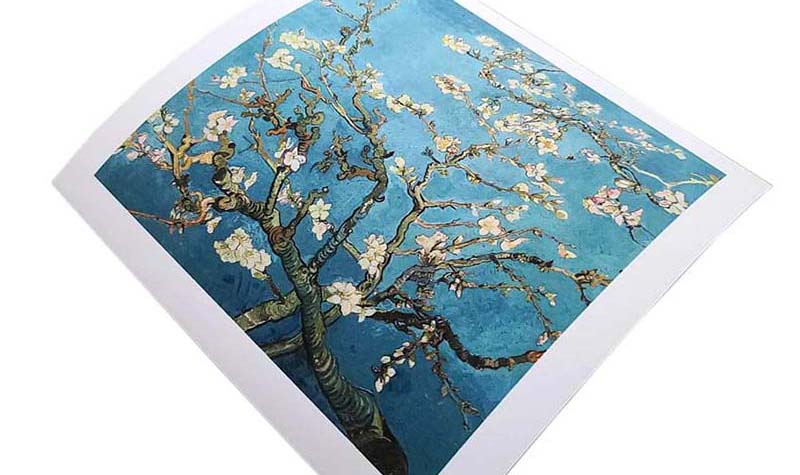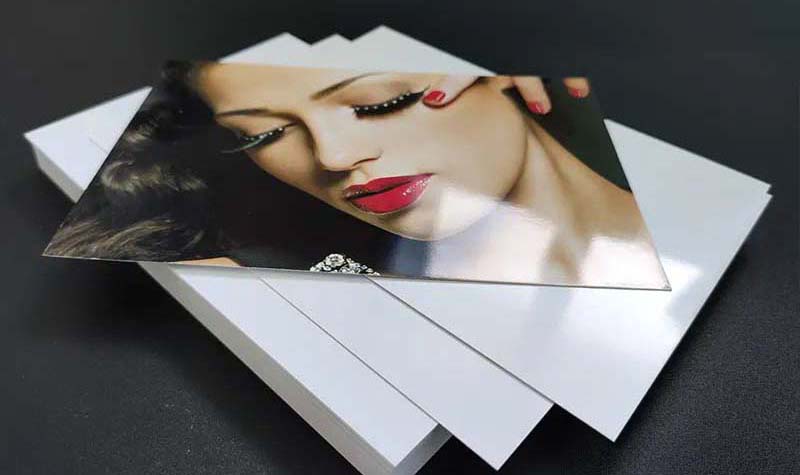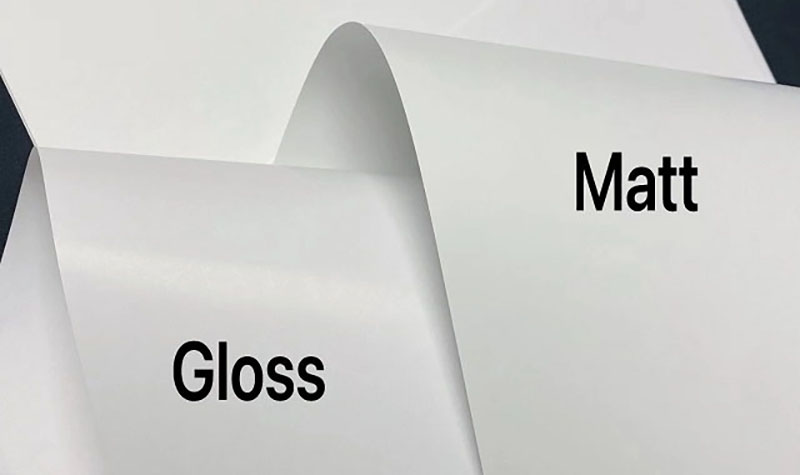Choosing between matte and glossy paper can significantly impact the appearance of your printed materials. Are you aiming for vibrant images that pop or a subtle, elegant finish that exudes sophistication? Understanding the differences between matte and glossy paper will help you select the perfect finish for your project.
In this guide, we’ll explore the characteristics, uses, pros, and cons of each to assist you in making an informed decision.
Understanding Paper Finishes
What Is Matte Paper?

Matte paper is a non-glossy paper type with a smooth, dull finish that absorbs ink well, resulting in softer images and reduced glare. It’s ideal for text-heavy documents and art prints where readability and subtlety are important.
Common Uses for Matte Paper
- Text Documents: Manuals, reports, and portfolios benefit from matte paper’s readability.
- Art Prints: The subtle elegance enhances artwork without distracting glare.
- Luxury Catalogs: Provides a sophisticated look that aligns with high-end branding.
- Frequent Handling: Resists fingerprints and smudges, maintaining a professional appearance over time.
What Is Glossy Paper?

Glossy paper features a shiny, reflective surface that enhances color vibrancy and sharpness. This finish makes images appear more vivid and is commonly used for photographs and promotional materials that need to capture attention.
Common Uses for Glossy Paper
- Photographs: Brings out rich colors and sharp details, making images pop.
- Brochures and Flyers: The eye-catching appeal is perfect for marketing materials.
- Promotional Materials: Ideal for making a bold statement and leaving a lasting impression.
- Magazines and Catalogs: Enhances visual content with high contrast and vibrancy.
Comparison of Matte and Glossy Paper
To help you understand the key differences, here’s a comparison table:
| Aspect | Matte Paper | Glossy Paper |
|---|---|---|
| Surface Finish | Non-reflective, smooth texture | Shiny, reflective surface |
| Color Vibrancy | Softer, muted colors | Vibrant, rich colors |
| Ideal For | Text documents, art prints, luxury catalogs | Photographs, brochures, promotional materials |
| Fingerprint Resistance | Resists fingerprints and smudges | Shows fingerprints and smudges |
| Reading Ease | Easier to read; no glare | Glare may hinder readability |
| Durability | High; withstands frequent handling | Moderate; may show wear over time |
| Cost | Generally more affordable | Typically more expensive |
Matte Paper vs Glossy Paper: Pros and Cons

Choosing between matte and glossy paper can feel like a big decision. Each type has its own set of advantages and disadvantages.
Advantages of Matte Paper
- Non-Reflective Surface: Reduces glare, making it easier to read, especially under bright lighting conditions.
- Fingerprint Resistance: Less prone to showing smudges and fingerprints, maintaining a clean appearance even with frequent handling.
- Professional Appearance: Offers a subtle and elegant look suitable for formal documents, art prints, and luxury catalogs.
- Ease of Reading: Ideal for text-heavy documents, as the lack of glare reduces eye strain.
Disadvantages of Matte Paper
- Muted Colors: Colors may appear less vibrant and more subdued compared to glossy paper.
- Less Sharpness: Fine details might not stand out as sharply due to higher ink absorption.
- Not Ideal for High-Impact Images: May not deliver the visual punch needed for certain promotional materials.
Advantages of Glossy Paper
- Vibrant Colors: Enhances color saturation, making images appear more vivid and rich.
- Sharp Details: Provides high contrast and clarity, bringing out fine details in photographs and graphics.
- Eye-Catching Appeal: The shiny, reflective surface captures attention, ideal for marketing materials and promotional items.
Disadvantages of Glossy Paper
- Glare and Reflection: The glossy finish can cause glare under bright lights, potentially making content harder to view.
- Fingerprint Visibility: More susceptible to showing fingerprints and smudges, requiring careful handling.
- Reading Difficulty: The reflective surface may make reading large amounts of text challenging.
Printed on Matte Paper vs Glossy Paper
Understanding how ink interacts with matte and glossy paper can help you make an informed decision for your printing projects. The type of paper finish affects the final appearance of printed images and text due to differences in ink absorption and light reflection.
Ink Absorption and Color Reproduction
Matte Paper
- Ink Absorption: Matte paper has a porous surface that absorbs more ink. This results in softer images with less contrast and saturation.
- Color Appearance: Colors appear more subdued and natural. Fine details might be slightly less sharp due to the ink spreading more within the fibers of the paper.
- Surface Reflection: The non-reflective finish reduces glare, providing a smooth, elegant look ideal for readability and a subtle aesthetic.
Glossy Paper
- Ink Absorption: Glossy paper has a coated, non-porous surface that prevents ink from being absorbed deeply. The ink sits atop the surface, drying in place.
- Color Appearance: Produces vibrant, high-contrast images with rich colors. Fine details are crisp and sharply defined.
- Surface Reflection: The shiny finish reflects light, giving images a luminous appearance but can cause glare under certain lighting conditions.

How to Choose the Right Paper for Your Project
Selecting between matte and glossy paper depends on several factors related to your project’s goals, audience, and practical considerations.
Purpose and Content Type
Think about what you’re printing. If your project involves photographs or high-impact visuals, glossy paper is often the preferred choice. The vibrant colors and sharp details make images stand out. For text-heavy documents, art prints, or materials where readability is crucial, matte paper is ideal due to its non-reflective surface and elegant finish.
Audience and Presentation
Consider who will be viewing your printed materials. If you’re targeting an audience that appreciates bold and vivid imagery, glossy paper may be more effective. On the other hand, if your audience values subtlety and sophistication, matte paper might resonate better. Additionally, think about the presentation environment. In brightly lit settings, matte paper reduces glare, enhancing visibility, while glossy paper can shine under controlled lighting.
Handling and Maintenance
Evaluate how the materials will be handled. Glossy paper is more susceptible to fingerprints and smudges, requiring careful handling. If your printed materials will be frequently handled or need to maintain a pristine appearance over time, matte paper’s resistance to smudges makes it a practical choice.
Budget and Availability
Budget considerations can influence your decision. Glossy paper often costs more due to its special coating, so if you’re on a tight budget, matte paper might be more economical. Check with local suppliers or online retailers to compare prices and availability for both paper types.
Personal Preference and Project Goals
Ultimately, your personal preference and the specific goals of your project play a significant role. Reflect on the message you want to convey and the aesthetic you wish to achieve. If you prefer the bold look of glossy paper that captures attention, it may be the right fit. If you lean toward the subtle elegance of matte paper, especially for professional or artistic works, then matte is likely the better choice.
Conclusion
In summary, the choice between matte and glossy paper depends on your specific needs and preferences. Consider the purpose, audience, content type, handling requirements, and desired aesthetic to select the paper that best suits your project.
If you aim for rich, vibrant images that capture attention, glossy paper is the ideal choice for photographs and promotional materials. Its shiny surface enhances color depth and visual appeal. Conversely, if you prefer a subtle, sophisticated look with easy readability, matte paper suits text-heavy documents and art prints, offering a non-reflective finish that resists fingerprints.
By carefully evaluating these factors, you can make an informed decision that enhances the quality and impact of your printed materials.
Enhance your printed materials by choosing the right paper finish. Whether you prefer the subtle elegance of matte or the vibrant impact of glossy, the choice is yours to make your project stand out.

